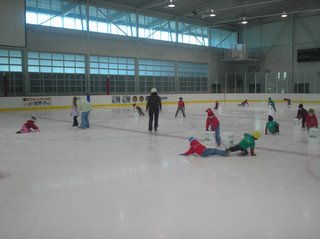This is an outstanding article and well worth reading. It makes me realize that what we have been doing for ten years is right on target. What Mrs. Faulk wanted is available, but not necessarily at the big places. Our teachers have known for years that educating children must be the primary goal of any good place and we have fought a steady shunning from the early childhood clique locally because our kind of education is just not doable in other places. I thank Cecelia for a wonderful article.By CECILIA LE
The News Journal
01/29/2006
Shannon Faulk wanted her son in a preschool program that would offer a real education -- not just a babysitting service. She wanted to expose him to a diverse group of youngsters. And she wanted something affordable.But the 41-year-old paralegal and mother of 4-year-old Seth didn't know if such a place existed.
"They were either for really, really poor people or people with really, really a lot of money, but there were not a lot of stimulating programs for, dare I say it, 'middle-class' people like me."
The problem she faced is common in Delaware: Government-subsidized and regulated preschool programs, such as Head Start, are available only to underprivileged families, while high-quality early education remains difficult to identify and difficult to afford for the middle class.
"Middle-income children are being left behind," said Libby Doggett, executive director of Pre-K Now, a national advocacy group that supports universal access to preschool. "Children in poverty have access to Head Start. Upper-income parents buy whatever is best for their child -- usually a preschool of very high quality. It's the middle class that's getting squeezed."
In Delaware, preschool programs cost anywhere from $100 to $1,000 for a four-week month -- lower than comparable states such as New Hampshire, Rhode Island and Vermont. But the quality of instruction and education level of teachers isn't as good, according to a recent University of Delaware study.
According to the National Institute for Early Education Research at Rutgers University, Delaware's state-funded preschool programs met seven of 10 quality standards in 2002-03. Delaware was praised for having fewer than 20 students in a class, serving a meal and giving teachers specialized training. However, Delaware preschools didn't require teachers to have a bachelor's degree. Arkansas met all 10 standards, while Pennsylvania met only two.
Several initiatives are forming to improve early education in Delaware -- such as a task force to study increasing teacher training and pay, and a star system to rate preschools -- but they are still in their infant stages.
"This state has put a lot of concentration on reforming the K-12 system, but we've done very little with early childhood education," said Evelyn Keating, provider services director with The Family and Workplace Connection, a Delaware nonprofit child care referral agency. "We can't wait until they get to kindergarten because then we're just playing catch-up."
Help for poor
Delaware children in poverty -- defined as a family of four making $19,350 or less annually -- and children with disabilities are eligible for free, public preschool from birth to age 5.
Families making up to twice the poverty level can get state vouchers to pay for child care. About 14,700 children -- nearly a third of those in child care -- receive such a voucher, which can cover all or some costs depending on income.
With poor children taken care of and higher-income families taking care of their own, the remaining middle class are left without the means to pay for a high-quality preschool or the knowledge to even identify one.
Faulk got references and used her own sleuthing skills to make her choice: St. Michael's School and Nursery in Wilmington. She was drawn to it because of its educational programs and the diversity of its students and staff.
The school, which received the Governor's Award for Excellence in 2002, charges about $550 a month for prekindergarteners. Preschool teachers, who handle newborns to 3-year-olds, have at least an associate's degree. All kindergarten teachers have a master's degree or are completing one.
And as director, Helen Riley has 35 years of experience.
The school Faulk picked is one that met many quality indicators in a 2003 University of Delaware study of 200 programs in the state.
The study determined that quality is connected to price, staff education and the director's experience. While publicly funded and regulated programs for poor families were of better quality than others, the study found the overall quality of Delaware's programs was mediocre to poor.
Many were lacking in language and literacy development, reasoning activities and even basic health and safety.
Authors pointed out that the quality of care is probably even worse than the study suggested, because the centers that allowed researchers to visit were of higher quality.
Shopping for quality
In the public eye, preschools have traditionally been seen as educational settings where children learn letters, numbers, manners and other skills to prepare for kindergarten. Day cares, in contrast, have been regarded more as babysitting services.Nowadays, because all providers are expected to provide learning activities, the state Office of Child Care Licensing doesn't distinguish between preschool and day care. Any licensed center can call itself a "preschool," but faces minimal requirements for teacher training and curriculum.That means it's up to parents to shop the wide variety of programs available and recognize the ones of high quality.National research shows children who attend high-quality preschool do better throughout school and, as adults, are more likely to go to college, get jobs and pay taxes.
Many states are expanding their programs in response to such research, as well as federal demands that they get all children up to grade level in reading and math.
States spent $3.6 billion on pre-K education in 2005-06, compared with only $200 million in 1998, according to Pre-K Now.
Another UD study tracking more than 700 disabled and poor children found that by fifth grade, those who had attended government-funded preschool were on a par with their peers in reading, with 73 percent passing state reading tests. The group that hadn't had preschool was doing far worse, with only 34 percent passing.
Those studies involved programs for 3- and 4-year-olds, but experts say preschool education should begin after birth and last until age 5, when the brain is growing most quickly.
"In many ways, it's the first 36 months that make the difference," said Michael Gamel-McCormick, who led both UD studies.
Waiting in line
Rep. Melanie George Marshall, D-Bear, said her goal is for every child to have access to quality early education.
But Marshall, who chairs a legislative task force on early childhood education, says a focus on expanding full-day kindergarten has consumed much of the state's attention and left preschool waiting in line.
"I was really bright-eyed and optimistic that we would be able to accomplish so much," when the task force was established in 2003, she said. "There's only so much money to go around. It's going to take longer than I had initially hoped.
"This isn't about looking after someone else's kids," Marshall added. "It's about getting their brains ready for school. It can't be any old program. The real issue is quality -- making quality affordable."
When picking a program, parents usually consider location, cost and hours, said Keating, from the referral agency. Judging quality is more complex.A high price tag doesn't guarantee a top-notch program or highly educated teachers -- but it's more likely, experts say. And parents who can't afford premium rates could sacrifice quality.
"People who are just 18 years old and breathing and aren't experienced and educated ... that's what we have in some of our family child care centers," Keating said.For Faulk, it was the educational programs that ultimately helped her pick St. Michael's for her son Seth.
"With his teachers now, one is Hispanic and they are learning Spanish -- who better to learn it from?" said Faulk, noting Seth can count to 20 in Spanish. And he gets field trips, yoga, nutritious meals and is learning social skills like sharing.
The state Department of Education's guidelines say preschools should provide activities that help 3- and 4-year-olds develop skills such as recognizing numbers, following directions and expressing care for others. Most learning is accomplished through play.
"You can't teach them the way you would older children," said Jeff Benatti, executive director of New Castle County Head Start. "You can't sit them down in front of a chalkboard and go, 'Two plus two equals four.' We don't believe that's the way 3- and 4-year-olds learn best."
Parents need to visit the program, ask questions and watch the children. They also might drop by to see how the school is run when visitors aren't expected.
Hands-on
At Children First Preschool in Hockessin, which last year won the Governor's Award for Excellence, each month has a theme.
This month, it's transportation, so one classroom's play area is an airport where children act as pilots, passengers and flight attendants. The children "sign up" to play by marking the station with a personalized clothespin.
"The real learning takes place when the children put their hands on things," said co-director and teacher Anna Traudt.
Pre-kindergartner Alexandra Cresci, wearing a birthday crown, painted her nails blue with a glittery marker.
"Look, I'm making a telescope," said classmate Tess Foote, peering through a paper towel roll she had colored.
Meanwhile, J. D. Gaylor practiced fine motor skills by picking up cloth balls with a pair of chopsticks.
Even though Heather Willis is a stay-at-home mom, she sent both her children to Children First: Henry, 4, and Ellie, 6, now in kindergarten.
She felt Ellie, more of a risk-taker, needed extra stimulation, while Henry would benefit from time away from mom.
"It was worth that sacrifice of not having that extra money," Willis said. "Both of them are more confident and more inquisitive. They learned how to play with friends and do things without me being around."
Children First, which charges $510 a month for a five-day-a-week program, requires teachers to have a degree in early childhood education or complete 60 hours of coursework.
But most programs don't. Thirty-eight percent of early care and education teachers have only a high school diploma or less, UD researchers found in the 2003 study.
Teachers are paid an average of $8.90 an hour, which is comparable to national pay.
"Some of them actually qualify for public assistance themselves, and that's sad," Keating said.
Better training
Several programs are in the works to improve early education in Delaware.
Teachers can get scholarships to work toward an early childhood credential or degree through the TEACH (Teacher Education and Compensation Helps) program, administered by the Family and Workplace Connection. After getting credentialed, they would be eligible for higher pay.
Rep. Marshall plans to introduce legislation soon that would create a task force to study other ways preschool teachers can get better training.
Early childhood advocates also want to create a rating system that would give stars to participating programs -- like those used for restaurants and hotels -- and grants to help them improve.
While the task force doesn't focus on the squeeze facing middle class families, both of those initiatives could help them identify quality programs they could afford.
Similar systems exist in other states, but Delaware still is seeking funding from government and private sources, said Keating, who hopes the Family and Workplace Connection will administer the system.
Meanwhile, Estela Lemus would give good marks to the Head Start at Absalom Jones Community Center in New Castle. She says her 5-year-old daughter, Andrea Rodriguez, has matured since starting there.
Andrea will be ready for school, her mother thinks.
"Her shyness is going away," she said. "She likes to read books and make up what's happening in the pictures. She has a cousin in kindergarten and she says, 'Mom, I want pretend homework.'"
Contact Cecilia Le at 324-2794 or
cle@delawareonline.com.























